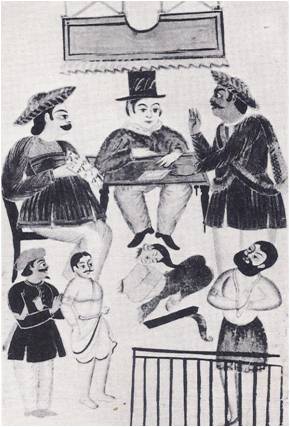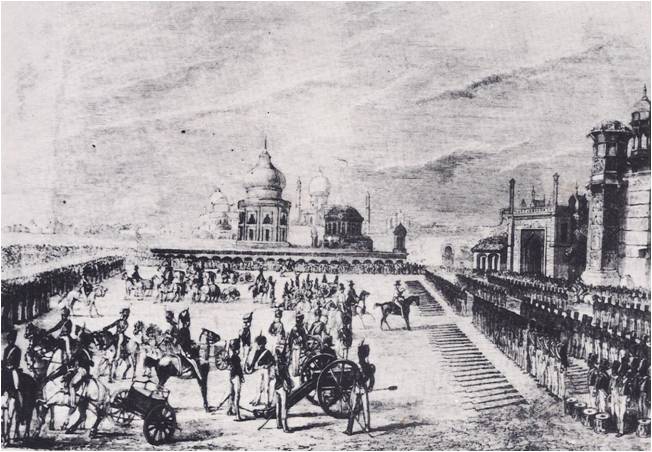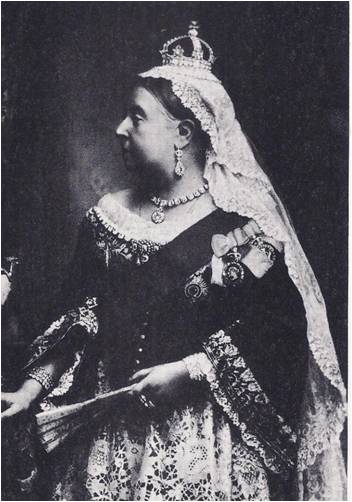In 1856, Great Britain was at war with Russia in the Black Sea area and with the Chinese emperor in south China. Many British troops had been withdrawn from India to fight on these battlefronts. As a result, nine-tenths of the 200,000-man army guarding Great Britain’s largest and richest possession, the subcontinent of India in south-central Asia, consisted of native soldiers called sepoys.
At the time, the British were putting a new type of rifle into service in the Indian Army. To load it, a rifleman had to insert each cartridge separately and the cartridges were covered with grease. In January of 1857, rumours began to circulate among the sepoys in the Ganges Valley. The cartridge grease, it was whispered, came from animals. Moslems believed that it came from pigs, which their religion taught them to shun in any form, while Hindus believed it came from cows, which they held sacred. So sepoys of both religions refused to handle the new rifles.
THE SEPOY REVOLT
This refusal to bear arms was an act of mutiny which the British felt they could not leave unpunished, but punishment only made the sepoys desperate. On May 10, troops at the key post of Meerut massacred the British officers and their families. Other garrisons rebelled and hordes of peasants, villagers, Moslem and Hindu, joined them. The uprising was supported by native princes, who were either fretting under British rule or feared that the British would soon take over their lands. By June, most of northeast India was in rebellion.

The Sepoy Revolt, as the rebellion was called, was the bloodiest event of Great Britain’s long history in India. Hundreds of Englishmen were slain, some with their families and countless thousands of Indians slaughtered in revenge by British troops and loyal sepoys. Cities were burned, looted and laid waste. Not until 1859, when the last rebel leader was tracked down and killed, did the violence end.
This great upheaval marked a turning point in Anglo-Indian affairs, for it led to basic reforms in British rule. An outworn system of government was discarded and a more just and efficient system set up in its place. The old system, a patchwork of policies and customs, had grown up slowly over more than a century.
India had been known in the West since ancient times. After Vasco da Gama’s famous voyage there in 1499, his fellow Portuguese set up trading posts where they bought Indian goods –spices‚ tea, silks, precious stones and gorgeously wrought and woven stuffs — to bring back to Europe in their ships. In the sixteenth century, Dutch traders took over most of the trade, but in the seventeenth century they lost all but a small share of it to traders from Great Britain and France.
These two powers were often at war during the eighteenth century and their forces in India battled over ports and territories. Slowly, the British defeated the French and drove them out. By the start of the nineteenth century, the British controlled about half of the vast peninsula, leaving their rivals only a few scraps of land on the coasts.

From London, the British government sent governors to India, but instead of ruling the country by themselves, the governors shared power with agents of the East India Company. For British India was not yet a British possession; it was a huge private holding of the trading company, operated for the benefit of its stockholders in Great Britain.
As time passed, however, the government became more deeply involved in Indian affairs. Its judges administered the laws, its fleets patrolled the surrounding ocean and its Indian Army, made up mostly of native soldiers under British officers, kept order in the land. One by one, it took over tasks of administration from the company.
Still the British did not rule openly. They preferred to govern in the name of Indian rulers with great prestige but little power. Although the Mogul Empire, which had once dominated all India, had long since lost real power, the British pretended it was as strong as ever. They made yearly payments to Mogul overlords, descendants of the last real emperors, for the use of Mogul seals on official papers. As a rule, the overlords squandered the money on building palaces and keeping themselves in luxury.
Indirect rule was troublesome, for the overlords could not always be trusted. At times, they plotted against the British with the princes of independent states outside India. To strengthen their hold on the country, the British took over such trouble spots by force or a show of force. They decreed that the lords of a ruler who died without leaving a son to take them over must automatically become theirs. Slowly, they added to their domain. By the end of the nineteenth century they controlled three-fifths of the peninsula and were much feared in the other two-fifths.
Then in l857, came the Sepoy Revolt, which threatened to oust the British from India altogether. This close call taught the British a number of useful lessons. For one thing, it taught them to take the religious feelings of their subjects seriously. Although they went on trying to stamp out such cruel practices as suttee — the burning alive of widows with the bodies of their husbands — they were now careful to respect other Indian traditions, such as the division of the people into numerous classes or castes.
After 1858, Great Britain ruled its Indian domain directly, through a civil service in which the top posts were reserved for British subjects. The East India Company lost its last vestiges of power and the “Mogul Empire” was quietly forgotten. Soon all India was under British control. In states that had been outside British India before the Sepoy Revolt, the rich landowners were allowed to keep their thrones. These rajahs and maharajahs did not really rule; British advisers at their courts made sure that they obeyed the government’s wishes.
“THE BRITISH LAKE”
In 1876, Queen Victoria took the title of Empress of India. This did not change anything, but it showed how important India had become to the British, especially since the opening of the Suez Canal seven years before. From India the British received tea, raw cotton, oilseeds and wheat, together with indigo for dyes and jute for burlap. In India, business boomed. The country came to have the densest railway network anywhere outside Europe and North America, but the majority of its people, who by 1914 numbered 315,000,000, remained miserably poor.

Its land, however, was rich and its great resources and huge population gave it a place of first importance in the British Empire. Much of the empire was, in fact, built around India. East of it lay Burma, Malaya, Australia and west of it the British colonies of East and South Africa. Like India itself, these lands fronted on the Indian Ocean. So much of the land around it belonged to Great Britain that the ocean came to be called “the British Lake.”
One stretch of Indian Ocean shore that was not British was the island chain known as the East Indies. From Sumatra, straddling the equator off the Malay Peninsula, the East Indies curved east in an arc of lesser islands three thousand miles long. The East Indies belonged to Holland.
At the start of the nineteenth century, the Dutch had occupied only Java, smaller than Sumatra but more densely populated. Then, one by one, they had taken over other islands, partly to get rid of troublesome native pirates who attacked their ships and trading posts. Finally, in the second half of the nineteenth century, they imposed their rule on the entire chain. One reason they did so was to satisfy Europe’s growing hunger for tropical produce, but another reason was to forestall their imperialist rivals. For Great Britain, France and Germany all had colonies nearby and were eager to share in the fabled wealth of the Indies.
The East Indies, much the most important colony in the Dutch Empire, supplied coffee, sugar, spices‚ tea and tropical woods. For a long time, the Dutch forced native farmers to bring them a part of their crops, as a kind of tax. After 1870, however, they allowed them to sell their produce as they chose.
Like the British in India after the Sepoy Revolt, the Dutch encouraged the people of the East Indies to keep their old customs. They did not want their subjects to think of themselves as a nation. Nevertheless, national feelings slowly began to form around the Moslem religion, which most of the people followed. By 1914, thanks to modern steamships, 20,000 Moslems made pilgrimages every year from the East Indies to Mecca. On their return, the pilgrims spread a revolutionary doctrine; they said that the Moslems of the islands must unite against the Christian rulers, the Dutch.





